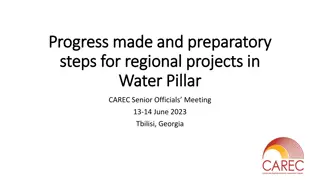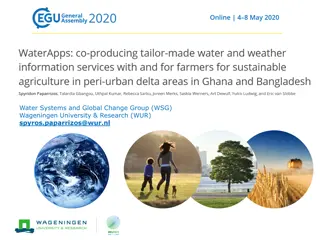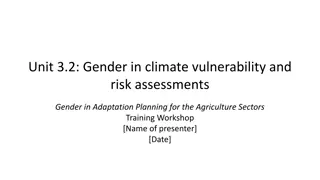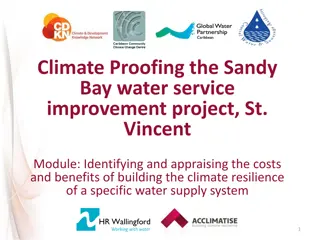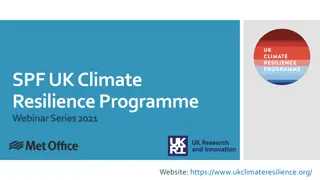Climate Risk-Informed Decision Analysis in Water Management Planning
The Climate Risk-Informed Decision Analysis (CRIDA) approach helps engineers bridge the gap between science, engineering, and policy in water management planning. It emphasizes incorporating climate change information, assessing vulnerabilities, and developing flexible adaptation pathways to address uncertainty and changing conditions. CRIDA guides decision-making by identifying problems, considering safety margins, evaluating alternative plans, and allowing stakeholders to define system failure.
Download Presentation

Please find below an Image/Link to download the presentation.
The content on the website is provided AS IS for your information and personal use only. It may not be sold, licensed, or shared on other websites without obtaining consent from the author.If you encounter any issues during the download, it is possible that the publisher has removed the file from their server.
You are allowed to download the files provided on this website for personal or commercial use, subject to the condition that they are used lawfully. All files are the property of their respective owners.
The content on the website is provided AS IS for your information and personal use only. It may not be sold, licensed, or shared on other websites without obtaining consent from the author.
E N D
Presentation Transcript
Climate Risk Informed Decision Climate Risk Informed Decision Analysis: Bridging Bridging the Gap between Science, Engineering, between Science, Engineering, and Analysis: the Gap and Policy Policy Kristin Gilroy, PhD International Center for Integrated Water Resources Management 24 February 2016
Purpose of CRIDA Engineers have always dealt with uncertainty Uncertainty does not stop How should engineers incorporate climate change information into the water management planning process? Safety Margins/ Freeboard decision making Identify Problems and Opportunities Vulnerability Assessment: Current and Future Select alternative plan Water Management Planning Cycle What has changed? Compare alternative plans Formulate alternative plans Nonstationarity Evaluate alternative plans Deep Uncertainty
Two Key Elements of CRIDA Decision Scaling Decision Scaling Adaptation Pathways Adaptation Pathways Available climate data doesn t always meet the problem at hand: time-scale differs, models perform poorly in geographic region, observed data not available for downscaling With limited information, decision makers risk over- or under-designing solutions Adaptation pathways illustrate flexible strategies to the decision maker Limiting analysis to GCM derived scenarios confines your decision space Choosing an action that has many transfer points in the future provides a low regret option as the science progresses Allow stakeholders to define system failure Climate Response Map for a Proposed Run-of-the-River Hydropower Project (Ray and Brown, 2015).
Where does CRIDA Fit into Planning Cycle? How does it influence decision making? Identify Problems and Opportunities Decision Scaling Vulnerability Assessment: Inventory and forecast conditions Select alternative plan Water Management Planning Cycle Decision Point 3: Influence of institutional/gov t capacity? Decision Point 1: Level of Analysis Formulate alternative plans Compare alternative plans Adaptation Pathways Decision Point 2: Additional Decision Criteria? Evaluate alternative plans
We need your help!!! Water Resources System Type Key Hydrology Statistic Confidence & Existing Tools Variability of flow or rainfall (monthly) Are those climate states plausible, suggesting high climate risk? Rainfall dependent water Supply System ?????? Persistence (or auto-correlation) of low flows or rainfall (monthly) Glacial dominated water Supply System Persistence of high mean temperatures (weekly? monthly?) ?????? How much uncertainty is there in available climate information? Maximum annual peak flow (daily) Flood Risk Reduction System ?????? Intensity-Duration-Frequency Curve (sub-daily) Coastal Risk Reduction Mean sea level (annual) ?????? Ecological All the above ??????
What does CRIDA add to traditional planning approaches? A broader vulnerability assessment 1. Guidance on the necessary level of analysis 2. Adaptation pathways to illustrate the flexibility 3. Guidance on preferred pathway decision criteria & role of institutional capacity 4.
Where does CRIDA fit in the 3 Pillars of Drought Preparedness?
What still needs to be done? Collaboration and Integration Opportunities w/ Climate Services for Enhanced Water Management Project Activity 1: Improve integrated drought risk management towards a policy for drought preparedness Activity 2: Training of multiple stakeholders to strengthen capacities on climate services targeting water resources management and to increase resilience to climate hazards Activity 3: Strengthening of the community of practice on dryland management (GWADI- LAC) to support development and implementation of climate risk management in the region Activity 4: Implementation of climate services to improve water management across spatial and temporal scales Activity 5: Building climate resilient watersheds while enhancing their ecosystem services
Questions? Solum certum nihil esse certi (the only certainty is uncertainty) - Pliny the Elder (23-79 A.D.), Historia Naturalis




